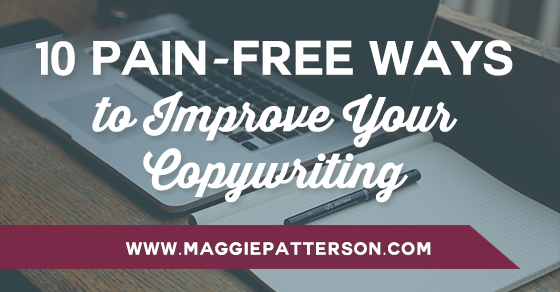
There are a lot of things you can outsource in your business, but your copy may not be one of them.
You’re probably sitting here thinking, “Wait, I thought Maggie wrote copy? Shouldn’t she be telling me all the reasons why I must hire a copywriter?”
In the perfect world, you can hand off your writing to a pro. But the truth is that most businesses can’t hand off all of their copy. The sheer volume of copy that needs to be created from blog posts to emails to websites – the list goes on and on.
Unless you’ve got a pretty healthy monthly run rate, hiring a copywriter for ALL of these things is likely not realistic.
And while we’re talking price, a great copywriter isn’t going to cost $99. Like most things in life, you get what you pay for. Not all copywriters are created equal. There’s a wide variety of experience ranging from people with years of pro writing to those who magically decided last week they were going to hang out their shingle.
Then there’s many different types of copywriters and it’s one hell of a specialized skill set. Know what you’re looking for: there’s a big difference between a hard core conversions copywriter who tests everything and someone who writes fluffy prose that says it converts.
Same thing goes for personality-driven copy. A writer needs to be able to channel YOUR personality and not just give you copy that’s in their voice. When someone can read your copy and know immediately who wrote it, that’s a problem.
Hiring a copywriter is sort of like dating in the age of Tinder. It’s complicated. But the bottomline is, like it or not, copywriter on speed dial (or not), you’re going to need to do some of your own writing.
Before you write another word, here are my 10 power tips to improve your copywriting now – all designed to help copywriting be pain-free (and maybe even enjoyable).
1. It’s Not All About You
The cardinal sin of copywriting is failing to understand that the copy isn’t all about you. Your copy needs to be written to meet the specific needs of your reader.
So if your about or home page leads with your qualifications or what you do, you’ve got it all dead wrong. The truth is your reader doesn’t care about you at all until you answer the question: “What’s in it for me?” Then, and only then, will they want to know about your qualifications and how you can help them.
2. Get Your Story Straight
Storytelling can be a powerful tool, but resist the urge to engage in sharing epic stories about your entire life history.
The goal of storytelling should be to create a cohesive thread that shares the stories of your background, your customers and what you believe. By focusing on those areas, you can ensure your storytelling efforts add value and create connection – and don’t have you jumping around like you’re sitting at the campfire sharing stories after one too many bottles of Wild Berry Cooler.
3. Make it Conversational
In the simplest terms, write like you talk. Unless you’re writing for lawyers and every other word is the f-bomb, then you may want to reconsider. The intent behind the concept of being conversational is ensuring that you sound like a human and not a nameless, faceless robotic corporation.
When it comes to conversational copy, you’ll need to find a line that works for your business when it comes to using expletives and slang. Find a way that’s aligned with how you really speak and isn’t just for dramatic effect because there’s nothing worse than finding out that the person behind the snarky or quippy blog posts actually has as much personality as a pair of tube socks.
Your mission is to create content that would match up with what you’d sound like if the reader were to call you right now. Run your copy through a filter to save yourself from overdoing or faking it.
4. Headlines that Hook
The adage “you’ve got one chance to make a first impression” applies to your headline.
If the title of your page or blog post totally blows, it’s unlikely that readers are going to keep reading. Don’t let your headline be an afterthought – instead, practice writing multiple options for each piece of content.
In my PR days when I was writing a lot of press releases, we’d often write five or more headlines when we created a draft release. A large part of the time spent writing a press release was on the headline, and the same goes with newspaper and magazine articles. Your headline is your invitation, your promise to the reader, so don’t slap something on there and call it good.
Not convinced? BuzzFeed writers create 25 headlines for each post and test them extensively. The headline matters, so don’t leave it to chance.
5. Speak Your Tribe’s Language
Every tribe, every niche, every industry has it’s own jargon, vocabulary and terminology. All of these things are shorthand that can help you create trust with your readers.
By speaking their language, they see you as knowledgeable, so when you’re writing, give careful consideration to the best way to communicate your point.
If you’re not sure exactly how to do this, pay attention to what your clients say to you. Do they use a particular word or term to describe their problem? Do they focus on specific challenges over others? Start there.
But remember, keep jargon to a minimum, or it can quickly turn copy that connects and copy that’s unintelligible.
6. Write for the Web
Writing for the web is different than other mediums. Readers on the web are skimmers (aka lazy readers), so you need to structure your content for maximum readability.
Use short paragraphs, lots of subheads to break up your copy, and bullets to help make copy skimmable. Sort of like what you see in action with this post.
7. Authority Rules
Write with authority and confidence. If you’re wishy-washy and your content isn’t definitive, you’re creating a question in the mind of your readers. The question being, “Can I really trust what he/she is saying?”
Copy needs to be confident and convince your readers that you know what the hell you’re talking about. Avoid the use of statements such as “I think,” which qualify what you’re saying.
Another thing that can trip you up is the use of complex language or big words. It doesn’t make you seem smart; it can easily make you sound pretentious. You don’t need to dumb it down for your audience, but don’t go out of your way to find big words that get you a high score if you’re playing Scrabble either.
Also, watch for buzzwords. They can make you seem like you’re trying too hard to be in-the-know.
8. Don’t Botch the Call to Action
If the headline is your promise, your call to action is where you seal the deal. Each piece of copy you create should have a specific purpose or goal, and that should be expressed in the call to action.
Avoid lame-o calls to action like click here and read more. You can do better to invite people into the next step. Have fun with it and make it so they can’t resist taking action.
9. Learn the Art of Persuasion
Great copy requires you to woo your readers and connect with them on a deeper level. Which is where the art of persuasion comes in.
While it may seem that rallying your readers into action is complicated, it’s simpler than most people realize. Gaining knowledge about how humans are hardwired can help you make better decisions on what to include in your copy.
If you want to learn more about persuasion, read Robert Cialdini’s book Influence, which breaks down the six principles of persuasion in detail: reciprocity, commitment, social proof, liking, authority and scarcity.
10. Get Edited
Everyone needs an editor. Even editors get their writing edited.
When you’re writing copy, you’re simply too close to the content and you’ll likely miss things. If you’re not working with someone who can edit for you, get someone on your team, recruit a friend or family member to proofread your work. Also, build time into your copywriting process to create breathing room so you can come back to content to fine-tune it later.
What’s one tip on this list you can go away and work on next time you sit down to write copy for your business? Share below.
[clickToTweet tweet=”10 power tips for improving your copywriting NOW (new blog post)” quote=”10 power tips for improving your copywriting NOW (new blog post)”]
Introducing the New Simplify Your Homepage Guide
 As a small business, you can’t leave your visitor’s experience on your website to chance. Which is why your homepage needs to hook your visitors so they stick around and ultimately take action by signing up for emails, booking an appointment or purchasing from you.
As a small business, you can’t leave your visitor’s experience on your website to chance. Which is why your homepage needs to hook your visitors so they stick around and ultimately take action by signing up for emails, booking an appointment or purchasing from you.
The biggest mistake most small businesses make when it comes to their homepage is having too much going on and not being clear about what actions the visitor should take next.


